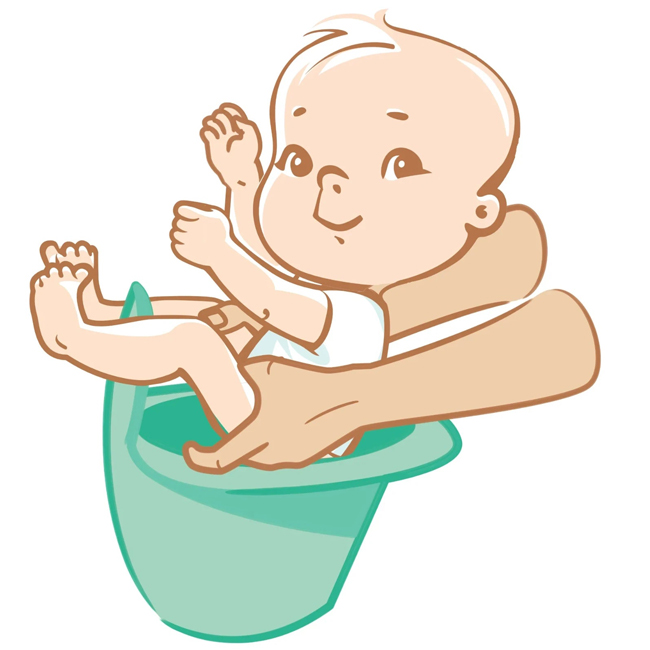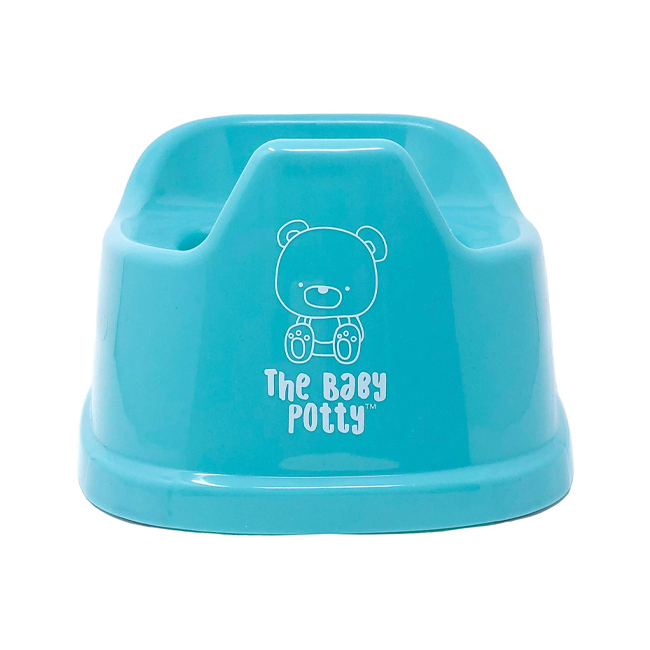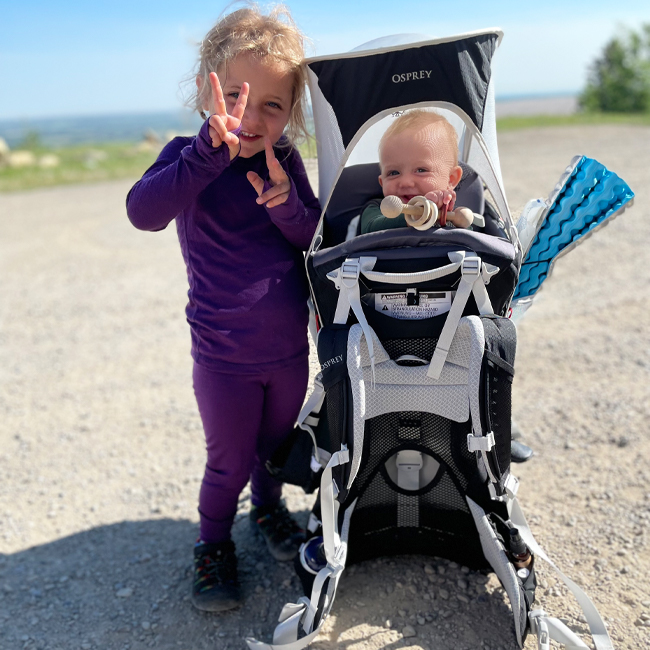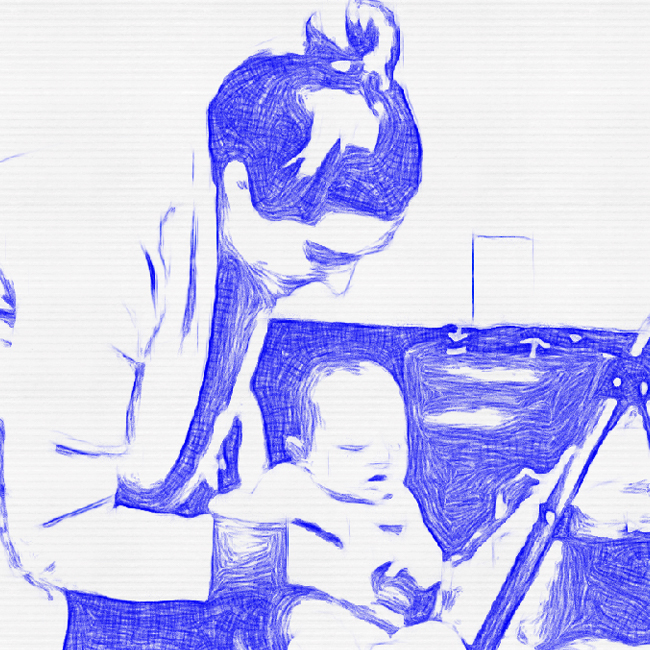Let’s start with the basics! What is Elimination Communication (EC)? Google defines it as, “a practice in which a caregiver uses timing, signals, cues, and intuition to address an infant’s need to eliminate waste. Caregivers try to recognize and respond to babies’ bodily needs and enable them to urinate and defecate in an appropriate place.” So, in summary, it’s a baby peeing and pooping on a toilet (or something of the sort), instead of [only] using a diaper. Before you hit x on reading more, keep in mind that many places in the world practice this regularly, because of convenience, and/or because of less/no access to diapers. Prior to having kids I heard about EC used in what I considered to be the most “extreme” ways, so I didn’t ever think it would be something we’d practice. I couldn’t imagine never using a diaper for my babies, walking around with a bucket, and having pee and poo all over everyone and everything. But then I learned more about it, and things changed…
With my first daughter, I set a toddler toilet out in the washroom when she turned 1-year-old, and every morning when I would wake up and go to the washroom, my daughter too would sit on her toilet and go. I was in awe, and I had no idea that that simple action was actually our first introduction to EC. We left it there, but then at 18-months, my daughter was fully potty trained and never saw a daytime diaper again. After talking to Andrea Olson (EC Expert) on our Kids Who Explore Podcast, I realized part-time EC was an option, it was do-able, and it had so many benefits. Here are some of the pros Andrea Olson listed in that podcast:
Elimination Communication Pros:
- You save a ton of money on diapers! [Makes cleaning cloth diapers easier and less too!]
- It reduces fussiness and colic-symptoms
- It helps make breastfeeding easier
- It gives babies a sense of control (in a good way)
- It’s makes for less to clean up, or wash
- The process is quicker
- No blow outs!
- Babies smell better
- It gives you and your kiddos a deeper connection
- [No diaper rash!]
Okay, so here I am intrigued with the idea, and I become pregnant with my second child, and I think I have to try EC. So I read, listen, and learn as much about it as I can. I tell my husband all about it – he laughingly shakes his head and goes, “okay” (Spoiler Alert: He is now the biggest advocate for it after seeing the results). I tell my parents and siblings and they all lovingly say, “let’s see how long you actually feel like doing this…” I too think we will try it with no pressure – on anyone – no pressure on baby, no pressure on us as caregivers, simply zero pressure…if it works, and if we love it, we continue, and if it doesn’t, no harm done and we move on. But, it turns out, it’s the greatest thing ever and I now cannot see doing it any other way! And by the way, my baby still has a cloth diaper on as a backup, I don’t walk around with a bucket, and there isn’t pee and poo on everything…nothing like I had originally pictured when I first heard about elimination communication! Oh, and I haven’t had to clean poop out of a diaper since we started at 2-weeks-old – and this isn’t just a selfish “I don’t want to clean poop out of a diaper” – it’s something that truly makes my son’s body and mind happy. Who wants to sit in a diaper full of poo anyway, right?
Now is a good time to send this reminder: Poop, even in disposable diapers, is never supposed to go in the landfill; the poop should be put into the toilet before the diaper is disposed of. Check the side of your diaper package and it will say this in small print…did I just blow your mind?!
Since I’m talking about how amazing all this is, let me share the cons we talked about on the podcast.
Elimination Communication Cons:
- Effort! There is the upfront work of being extremely present and learning your baby’s cues [but maybe this is a pro??]
- After getting out of diapers completely, sometimes parents/kids don’t know how to “finalize the potty training” [Here’s a blog post on how we had a beautiful, and smooth potty training experience]
When Can You Start?
You can start as early as day one! I gave myself 2 weeks grace – partly to find a new rhythm with two kids, to allow myself space to heal, and because my parents were in town helping. Next go around, I can’t say if I would give us that much time before starting or not, but it didn’t hinder us in any way. And if you haven’t started yet, it isn’t too late, but I do think there are benefits to starting before baby becomes mobile and they get used to this just being their normal! Remember, I didn’t even know I was doing part-time EC with my daughter at 1-year-old, and it rocked, so start whenever. If you’re reading this and your kiddo is 18-months or older, depending on the kid, you can likely go straight to potty training, and skip EC all together.

What if other caregivers don’t practice EC like you do?
Because I’m with my kiddos full-time, my husband and I haven’t had to explain the process to other caregivers or daycares, but from what I’ve learned you can either help teach caregivers the simplicity of it to apply EC practices when you’re not around, or if the child only experiences EC with you at home, that’s okay too, and it’s still beneficial! I have had many friends/family members who saw the ease of EC and then chose to practice it with their own babies – sometimes seeing is believing!!
What does part-time EC look like? Explain the process.
Okay, so when I say part-time EC, it’s because my baby does still use a diaper and I don’t practice at night – sleep trumps the toilet, my friends! In EC there is something called the 4 Easy Catches, which includes wake ups, diaper changes, poops, transitions (getting in and out of something). What EC looks like for us is mostly this!!
My son wakes up in the morning and I offer him the toilet. Throughout the day, anytime after he eats, I offer him the toilet (this is when people would usually be changing a diaper anyway). Throughout the day, anytime he cues that he needs to use the toilet, I offer him the toilet. This is the part that gets people confused – what do you mean he cues he has to go to the washroom? Oh, he does, and all babies do and continue to if their cues are answered, but we will get to that in a second. [PS he always cues a poop, which is why I never have to change a poop-filled diaper – win for everyone!]. Throughout the day, if we are getting in the car or doing a big transition, I may offer him the toilet – this one is based on discretion. Now, if you’re feeling overwhelmed – I promise it’s not overwhelming – remember these are times that you would normally be changing a diaper anyways, but now without the mess. Something that I have found helpful is having my kiddo wear clothes that are easy to get on and off, but this would be just as relevant if I was changing his diaper, and because we never have blowouts, we go through less outfit changes (another laundry bonus!).
When ECers offer the toilet, they usually use sound recognition, like “pssss” for pee and “mmm mmm” for poo. I have chosen to simply speak the way I would to my older kiddo too. Before I offer my son the toilet, we use baby sign language, so I’ll sign and say something along the lines of, “I’m going to change your diaper and take you to the toilet.” When I offer my son the toilet, I say, “Do you need to pee or poo?” Once he goes, I say, “Thank you for peeing/pooping on the toilet.” Or, if he doesn’t need to go, I say, “Okay, you’re all done?”
You can use whatever language you feel comfortable with, but the biggest thing is consistency. They get used to what you’re saying and know what you’re asking at a very young age!
What toilet do we use?
For the first six months, we really liked having the Baby Potty – I would hold him on it with his back to my belly and my hands under his knees to have him safe and cozy on the toilet. We have always done diaper changes on the ground, so this transition isn’t awkward at all. We also had the BabyBjorn toddler toilet and the BabyBjorn training toilet topper for my older daughter before and all those work just fine too. When we are out and about somewhere, or on vacation, or now that my son is eating solids, we just use the big toilet, and it’s a dream to simply flush it all down the toilet without transferring and washing the little toilet. If some people prefer that from the get-go, or to use the sink for pees in the early days, that works too. So many options!

How have his cues/signs changed with age?
When my son was little-little, he would do this little foot kick and/or have a specific cry to say he needed to use the toilet. Some people like to do “naked blanket time” to learn their cues – we never did this, and I still learned his cues from taking notice over time. Once he started solids, his cues became more of a grunt-like warning, or sometimes a certain cry. He does sign for “milk” and “all done,” so being consistent with baby sign language will help him communicate that in the future, as well. We have had quite a bit of luck that we haven’t really had an “inconvenient poop time” where he is telling me in the car or in the pool or name inconvenient place, but if that was the case you would need to go change a diaper anyhow, so you could decide if you tell them it’s okay to go in their diaper until you can get to a place to change them, or if you have the capacity to take them at that moment. I also think offering the toilet before these big transitions helps a lot!
What does hiking/adventuring with EC look like?
I always pack a toddler toilet in my car and offer my kids the toilet before and after adventures – believe me, when you’re out in the middle of nowhere, you want a toddler toilet. Just put the toddler toilet in your trunk…you won’t ever regret it! I’ve known many adults who have used them, possibly even my pregnant self…
Or if they need to go on the trail, find a private spot, use ‘your helpful hands underneath the backs of their knees’ position and eliminate the waste in an appropriate place.

Is this just a lot of work for the caregiver?
This is the question I get most often, and truth be told, I thought it before myself. I’ve heard people say, “aren’t we just training the adult?” In a way, yes, training the adult to listen to the child’s needs. BUT I would also say, the work on the part of the caregiver is happening somewhere, by either supporting them on the toilet, or cleaning a diaper.
You can choose if EC is for you, but if it is, I wanted to let people know it can be easier than you think, and it can be a whole lot of amazing!

Resources Mentioned
Go Diaper Free
Book
Tiny Potty
Kids Who Explore Podcast
Andrea Olson Podcast
